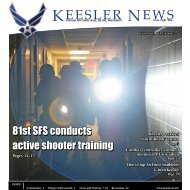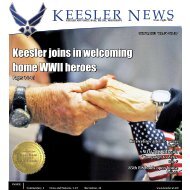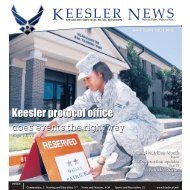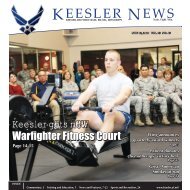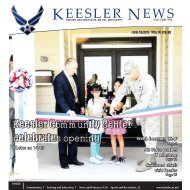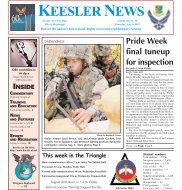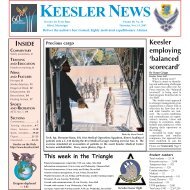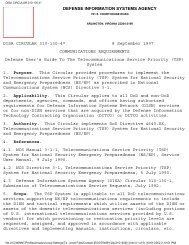KEESLER NEWS - Keesler Air Force Base - Air Force Link
KEESLER NEWS - Keesler Air Force Base - Air Force Link
KEESLER NEWS - Keesler Air Force Base - Air Force Link
You also want an ePaper? Increase the reach of your titles
YUMPU automatically turns print PDFs into web optimized ePapers that Google loves.
Colonel Taylor is front<br />
and center with Afghan<br />
soldiers in the advanced<br />
medical technician program<br />
she launched.<br />
Ultimately, this oneyear<br />
course could produce<br />
enough AMTs to<br />
increase support staff<br />
by 60 percent.<br />
Courtesy photo<br />
Nurse plays role in enhancing<br />
medical care for Afghan troops<br />
By Steve Pivnick<br />
81st Medical Group Public Affairs<br />
Lt. Col. Christine Taylor is proud of the<br />
role she played in enhancing the future of<br />
health care for Afghanistan’s national army,<br />
police force and their families.<br />
Colonel Taylor, flight commander of the<br />
81st Medical Operations Squadron family<br />
health care clinic, recently returned from more<br />
than six months in Afghanistan in support of<br />
Operation Enduring Freedom. She served as<br />
chief nurse for the Command Surgeon General<br />
Office under the Combined Security Transition<br />
Command, a U.S. Army-led organization located<br />
at Kabul’s Camp Eggers.<br />
She left on her deployment in March 2008<br />
following four weeks of pre-deployment<br />
combat skills training at Fort McCoy, Wisc.<br />
She returned in November.<br />
“I worked in a joint operational environment,”<br />
she said. “I was deeply involved in<br />
helping rebuild health-care infrastructure programs<br />
and management reform for the<br />
Afghanistan National Security <strong>Force</strong>s’<br />
nation-building operations.<br />
“This country has suffered with three<br />
decades of warfare, so it was no surprise to me<br />
that nursing practice was substandard due to an<br />
array of reasons. However, I found their<br />
biggest challenges were lack of nursing education<br />
and staff development programs. So my<br />
highest priority was to focus on those areas.<br />
Fortunately, what made all the difference in<br />
standing up new initiatives was how the<br />
Afghans embraced my mentorship and help.”<br />
The Afghanistan National Army force<br />
structure consisted of about 245 nursing personnel,<br />
insufficient to care for 68,000 troops.<br />
“The current nursing force structure would<br />
be woefully inadequate as the Afghan army<br />
expands in the next two years to 120,000,” she<br />
said. “To stimulate progress before this surge<br />
occurred, I stood up the first ANA advanced<br />
medical technician course. The primary goal<br />
of this program is to bridge the nursing gap by<br />
training noncommissioned officer medics to<br />
become highly-skilled functional nurses, the<br />
equivalent of licensed vocational nurses in the<br />
U.S. Ultimately, this one-year course could<br />
possibly produce enough AMTs to increase<br />
support staff by 60 percent.”<br />
Colonel Taylor explained the curriculum<br />
offers a broad field of clinical nursing and<br />
leadership subjects to train medics also as<br />
future leaders.<br />
“After months of planning, the first class<br />
kicked off Oct. 12 with 38 students from various<br />
regions of Afghanistan,” she continued. “Of the<br />
38 students, three females were enrolled, which<br />
was a significant milestone based on Afghan<br />
cultural belief regarding women being members<br />
of the ANA military force.”<br />
The colonel also organized the first ANA<br />
nursing symposium, held in conjunction with<br />
the ANA medical leadership conference.<br />
“Historically, this conference is primarily<br />
attended by senior leaders and physicians, so<br />
having each regional ANA chief nurse showcase<br />
their nursing processes and future goals to this<br />
audience were a huge step for ANA nurses.”<br />
She added, “I worked very closely with the<br />
embedded transition team nurses located at<br />
forward operating bases. One initiative<br />
implemented to standardize training and nursing<br />
practice throughout the five regional<br />
FOBs was a nursing training module program.<br />
This made a significant impact on<br />
standardizing nursing care and training.”<br />
She mentioned the command surgeon staff<br />
frequently deployed to FOBs with regional hospitals<br />
“in full battle gear” to ensure embedded<br />
Please see Deployment, Page 17<br />
Don’t drink and drive.<br />
Call 377-SAVE for a safe ride home.



